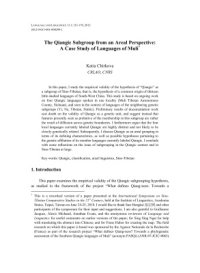
Ebook: The Qiangic subgroup from an areal perspective: a case study of languages of Muli
Author: Chirkova Katia.
- Genre: Linguistics // Foreign
- Tags: Языки и языкознание, Цянские языки
- Language: Qiangic-English
- pdf
Taipei: Academia Sinica. Language and Linguistics, 2012, 13(1), 133–170 p.In this paper, I study the empirical validity of the hypothesis of “Qiangic” as a subgroup of Sino-Tibetan, that is, the hypothesis of a common origin of thirteen little-studied languages of South-West China. This study is based on ongoing work on four Qiangic languages spoken in one locality (Muli Tibetan Autonomous County, Sichuan), and seen in the context of languages of the neighboring genetic subgroups (Yi, Na, Tibetan, Sinitic). Preliminary results of documentation work cast doubt on the validity of Qiangic as a genetic unit, and suggest instead that features presently seen as probative of the membership in this subgroup are rather the result of diffusion across genetic boundaries. I furthermore argue that the four local languages currently labeled Qiangic are highly distinct and not likely to be closely genetically related. Subsequently, I discuss Qiangic as an areal grouping in terms of its defining characteristics, as well as possible hypotheses pertaining to the genetic affiliation of its member languages currently labeled Qiangic. I conclude with some reflections on the issue of subgrouping in the Qiangic context and in Sino-Tibetan at large.
Download the book The Qiangic subgroup from an areal perspective: a case study of languages of Muli for free or read online
Continue reading on any device:

Last viewed books
Related books
{related-news}
Comments (0)